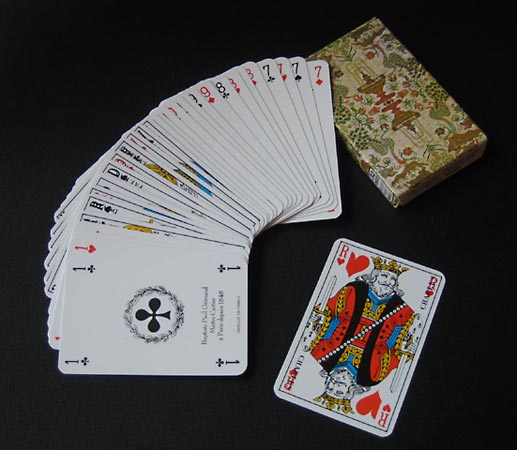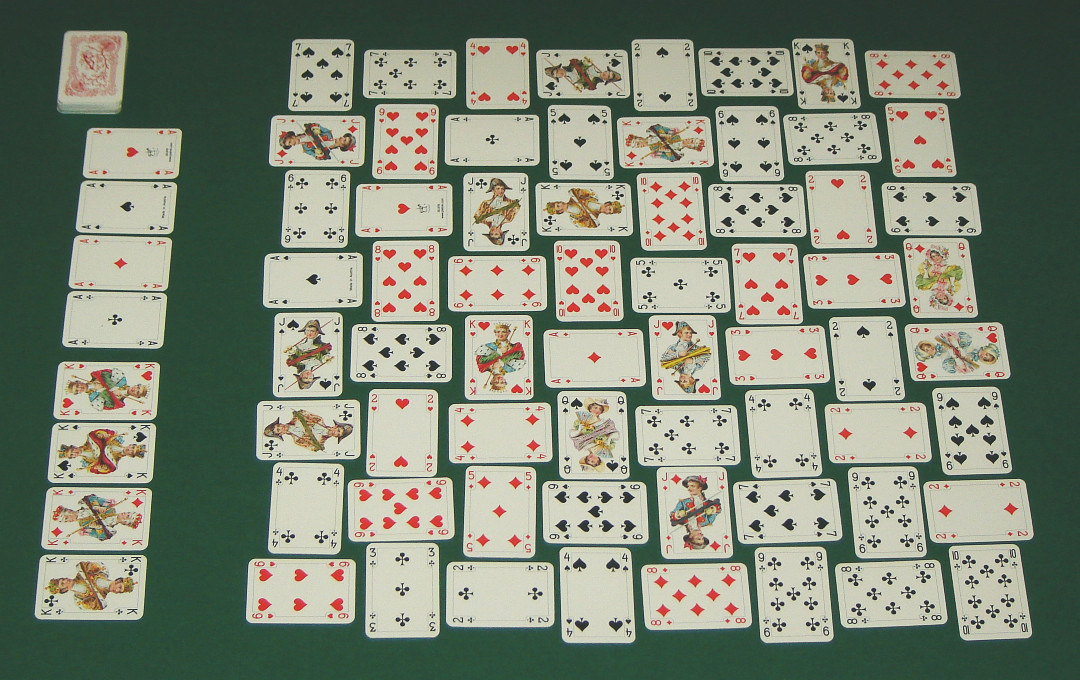|
Piquet Pack
A Piquet pack or, less commonly, a Piquet deck, is a pack of 32 French suited cards that is used for a wide range of card games. The name derives from the game of Piquet which was commonly played in Britain and Europe until the 20th century and is still occasionally played by connoisseurs. In the Netherlands it is referred to as a Jass pack, a term derived from games of the Jass type. Also referred to as Piquet cards, Piquet packs are still produced as standard packs of cards today, especially in Europe, for example to play the German national game of Skat (card game), Skat. A Piquet pack also may be Stripped deck, formed from a standard 52-card French pack by simply removing the Deuce (playing card), Deuces, Trey (playing card), Treys, Fours, Fives and Sixes. History The French Piquet pack originally comprised 36 cards, but was reduced to 32 cards around 1700. The 36-card packs continued to be produced in France until at least 1775, but thereafter became extinct. It is known th ... [...More Info...] [...Related Items...] OR: [Wikipedia] [Google] [Baidu] |
Écarté
Écarté () is an old French casino game for two players that is still played today. It is a trick-taking game, similar to whist, but with a special and eponymous discarding phase; the word ''écarté'' means "discarded". Écarté was popular in the 19th century, but is now rarely played. It is described as "an elegant two-player derivative of Triomphe [that is] quite fun to play" and a "classic that should be known to all educated card players." Play All cards from two to six are removed from a 52-card pack, to produce the Piquet pack of thirty-two cards, which rank from the lowest 7, 8, 9, 10, ace, Jack (playing card), knave, queen (playing card), queen, to king (playing card), king high. Note that the ace ranks between ten and knave, making the king the highest card. The players cut to determine the dealer, who deals five cards each in packets of two and three, or three and two, either to whim or some agreement. The eleventh card is dealt face up to determine the trump suit ... [...More Info...] [...Related Items...] OR: [Wikipedia] [Google] [Baidu] |
List Of Traditional Card And Tile Packs
This is a list of traditional sets of playing cards or tile-based game, gaming tiles such as mahjong tiles or dominoes that are still in modern use. A typical traditional pack of playing cards consists of up to 52 regular cards, organized into four card suit, suits, and optionally some additional cards meant for playing, such as Joker card, jokers or Trump (card games), tarot trumps. The cards of each suit typically form a hierarchy of ranks. However, some traditional packs, especially from Asia, follow a different scheme. French suited French playing cards, French-suited cards are the most popular design and can be found in most countries. Historically, kings were the highest cards and aces were the lowest, and this hierarchy is sometimes still prescribed for cutting. Aces are now the most common high card in most games. In ace–ten card games such as pinochle, tens have the second-highest card-point value and therefore tend to rank ''high'' between ace and king rather than in t ... [...More Info...] [...Related Items...] OR: [Wikipedia] [Google] [Baidu] |
Skat Pack
German-suited playing cards are a very common style of traditional playing card used in many parts of Central Europe characterised by 32- or 36-card packs with the suits of Acorns (''Eichel'' or ''Kreuz''), Leaves (''GrĂĽn'', ''Blatt'', ''Laub'', ''Pik'' or ''Gras''), Hearts (''Herz'' or ''Rot'') and Bells (''Schelle'', ''Schell'' or ''Bolle''). The German suit system is one of the oldest, becoming standard around 1450 and, a few decades later, influencing the design of the now international French suit system of Clubs, Spades, Hearts and Diamonds. Today German-suited playing cards are common in south and east Germany, Austria, German-speaking Switzerland, Liechtenstein, north Italy, Hungary, Czech Republic, Slovakia, Slovenia, Croatia, Bosnia, northern Serbia (Vojvodina province), southern Poland and central and western Romania. History Playing cards (''Spielkarten'') originally entered German-speaking lands around the late 1370s. The earliest cards were probably Latin-su ... [...More Info...] [...Related Items...] OR: [Wikipedia] [Google] [Baidu] |
Gambling Game
Gambling (also known as betting or gaming) is the wagering of something of value ("the stakes") on a random event with the intent of winning something else of value, where instances of strategy are discounted. Gambling thus requires three elements to be present: consideration (an amount wagered), risk (chance), and a prize. The outcome of the wager is often immediate, such as a single roll of dice, a spin of a roulette wheel, or a horse crossing the finish line, but longer time frames are also common, allowing wagers on the outcome of a future sports contest or even an entire sports season. The term "gaming" in this context typically refers to instances in which the activity has been specifically permitted by law. The two words are not mutually exclusive; ''i.e.'', a "gaming" company offers (legal) "gambling" activities to the public and may be regulated by one of many gaming control boards, for example, the Nevada Gaming Control Board. However, this distinction is not universa ... [...More Info...] [...Related Items...] OR: [Wikipedia] [Google] [Baidu] |
Rams (card Game)
Rams is a European trick-taking card game related to Nap and Loo, and may be played by any number of persons not exceeding nine, although five or seven make a good game. In Belgium and France, the game of Rams is also spelt Rammes or Rems, in Germany, Rams, Rammes, Ramsch, Ramschen, Ramscheln or Ramsen, in Austria, Ramsen and Ramschen, and, in America, Rounce. The basic idea is fairly constant, but scoring systems vary. It was a widespread European gambling and drinking game that is still popular today. During the 19th century, it was introduced as Rounce in America and played with a 52-card deck without any difference between simples and doubles and with no General Rounce announcement. In the modern German variety of the game, Ramscheln, the 7 is the second best trump ranking next below the ace. History Parlett describes Rams as a "nineteenth-century French, Alsatian and Belgian" pastime, representative of a "very loose-knit group of gambling and drinking games". In fact, ... [...More Info...] [...Related Items...] OR: [Wikipedia] [Google] [Baidu] |
Tell Pack
German-suited playing cards are a very common style of traditional playing card used in many parts of Central Europe characterised by 32- or 36-card packs with the suits of Acorns (''Eichel'' or ''Kreuz''), Leaves (''GrĂĽn'', ''Blatt'', ''Laub'', ''Pik'' or ''Gras''), Hearts (''Herz'' or ''Rot'') and Bells (''Schelle'', ''Schell'' or ''Bolle''). The German suit system is one of the oldest, becoming standard around 1450 and, a few decades later, influencing the design of the now international French suit system of Clubs, Spades, Hearts and Diamonds. Today German-suited playing cards are common in south and east Germany, Austria, German-speaking Switzerland, Liechtenstein, north Italy, Hungary, Czech Republic, Slovakia, Slovenia, Croatia, Bosnia, northern Serbia (Vojvodina province), southern Poland and central and western Romania. History Playing cards (''Spielkarten'') originally entered German-speaking lands around the late 1370s. The earliest cards were probably Latin-su ... [...More Info...] [...Related Items...] OR: [Wikipedia] [Google] [Baidu] |
Préférence
Préférence, frequently spelt Preference, is a Central Europe, Central and Eastern European 10-card plain-trick game with bidding (cards), bidding, played by three players with a 32-card Piquet deck, and probably originating in early 19th century Austria, becoming the second most popular game in Vienna by 1980. It also took off in Russia where it was played by the higher echelons of society, the regional variant known as Preferans being still very popular in that country, while other variants are played from Lithuania to Greece.. History In spite of the game's French name and a number of French terms, it has always been mostly unknown in France.. A game of this name was already mentioned as popular in Vienna in 1803, but Depaulis has found references as early as 1801 in Bohemia and notes that it may even have been known in Russia before 1800. Nevertheless, the earliest known description is in an 1829 Austrian game anthology,. Préférence quickly became popular in Imperial Russia ... [...More Info...] [...Related Items...] OR: [Wikipedia] [Google] [Baidu] |
Little Lots
Little Lots is a patience game and one of the most popular and widespread card games in the world. History Little Lots probably originated in France where it is recorded as early as 1857 as Les petits Paquets, some years before Edna Cheney records its first appearance in the English language in 1869. Cards A 32-card Piquet or Skat pack is used; alternatively remove the Sixes and below from a standard 52-card pack. Rules The following rules are based on those for ''Die Acht-Päckchen-Patience'' ("The Eight Packet Patience")''Die Acht-Päckchen-Patience'' at www.allekartenspiele.de. Retrieved 24 Jun 2019 at the ''Alle Karten Spiele'' website. The pack is dealt to eight piles, each ... [...More Info...] [...Related Items...] OR: [Wikipedia] [Google] [Baidu] |
Klaverjas
Klaverjas () or Klaverjassen () is a Dutch four-player trick-taking card game that uses a Piquet pack of 32 playing cards. It is closely related to the game of Klaberjass (also known as Bela) and is one of the most popular card games in the Netherlands, traditionally played in cafes and social clubs. It offers a considerable level of complexity and depth. It has numerous variants, but its basic rules are universal. History The name dates to 1890–95 from the Dutch word ''klaverjas'', combining ''klaver'' (the suit of clubs, literally "clover") plus ''jas'', the original name for the highest trump card.Random House Unabridged Dictionary 200 at Dictionary.com According to Scarne,John Scarne ''Scarne on Card Games: How to Play and Win at Poker, Pinochle, Blackjack, Gin and Other Popular Card Games'' pg. 414 Dover Publications (2004) its origin has been variously claimed by the Dutch, Swiss, French, and Hungarians. Parlett unequivocally states that its family of games originated ... [...More Info...] [...Related Items...] OR: [Wikipedia] [Google] [Baidu] |
Patience (game)
Patience (Europe), card solitaire, or solitaire (US/Canada), is a genre of card games whose common feature is that the aim is to arrange the cards in some systematic order or, in a few cases, to pair them off in order to discard them. Most are intended for play by a single player, but there are varieties for two or more players. Genre names 'Patience' is the earliest recorded name for this type of card game in both British and American sources. The word derives from the games being seen as an exercise in patience.Parlett (1991), pp. 157–161. Although the name solitaire became common in North America for this type of game during the 20th century, British games scholar David Parlett argues that there are good reasons for preferring the name 'patience'. Firstly, ''patience'' refers specifically to card games, whereas ''solitaire'' may also refer to games played with dominoes or peg and board games. Secondly, any game of patience may be played competitively by two or more players ... [...More Info...] [...Related Items...] OR: [Wikipedia] [Google] [Baidu] |
Hope Deferred
Hope Deferred is a simple game of patience, played with a French-suited Piquet pack of 32 cards. The aim of the game is to get rid of all the Clubs from the pack. History The game is first recorded by Professor Hoffmann in 1892 as Hope.Hoffmann (1892), p. 11. In this earliest version, the player chooses the suit to eliminate, but Clubs is given as the example. In all later versions, Clubs is automatically the discard suit and the game is variously called Knockout or Hope Deferred.Dick (1898), p. 108.Parlett (1979), p. 180. The game does not surface very frequently in the literature. Rules Hope The following are the original Hoffmann rules: The game is played with 32 cards ranking from 7 to Ace in each suit. The player chooses a suit, say Clubs, shuffles the pack and deals 3 cards to the table in a row, setting aside any Clubs. Another 3 cards are dealt and the procedure repeated. This is done five times, i.e. 15 cards are dealt '' in toto''. The cards are then reshuffled (ex ... [...More Info...] [...Related Items...] OR: [Wikipedia] [Google] [Baidu] |






